 |
|
|
BOOK SALE - I'm selling off some scholarly books via Amazon Marketplace. Have a look!

|
2007
October
31
|
Got one after all
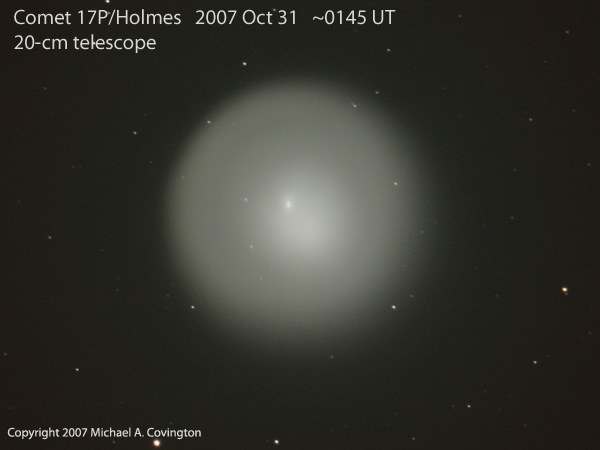
The clouds cleared and I got one more picture of 17P/Holmes.
This is a stack of 10-, 30-, and 90-second exposures combined using
Jerry Lodriguss' layer-masking
technique.
But I don't plan to continue photographing the comet daily. It has settled down into a routine.
I'll photograph it at 2-day intervals or whenever it seems to have undergone a change other
than just gradual expansion.
Permanent link to this entry


|

|
2007
October
31
|
What's new besides the comet?
For pictures of Comet Holmes
click here and keep scrolling down.
Tonight (Oct. 30) it's cloudy, so after 5 consecutive nights of
astrophotography I'm apparently going to miss one.
The strange case of the Pirahã:
One of the axioms of modern linguistics is that all languages are about equally complicated,
although there are trade-offs (e.g., more complex word formation in Turkish vs. more complex sentence
structure in English).
But my colleague Bess Fjordbak sends along
this New Yorker article
about the Pirahã tribe of Brazil, whose language (and thinking)
seems to be genuinely deficient. If current research is right, the Pirahã have no sentences
within sentences (hence no way to say "So-and-so may not be true" or "He thinks so-and-so") and no way to talk
about hypothetical situations. Why? Would-be racists will have a field day here, thinking an
inferior race has actually been found — but wait a minute. This is a very tiny part of the
human population and hasn't been investigated very thoroughly. A lot more research is certainly warranted.
Next credit crunch:
After subprime mortgages come
credit cards.
Who could ever have guessed?
DPReview does the Canon EOS 40D:
Full review here.
In brief, this is a really good camera.
See the comparison to Nikon D200 here
and the sage advice about dynamic range
(including highlight priority mode) here.
And we learn that High ISO noise reduction only reduces chrominance noise, not fine detail. Excellent!
My old friend Rowan Williams (well, I never actually met him, but we were at
the same Cambridge college at different times, and his wife is someone I used to know slightly)
is
trying to nudge the Church of England
away from its current, extremely permissive position on abortion.
(The people who actually attend church are more conservative than the hierarchy, I think.)
Good for him.
The Church of England is run by means of gentle nudges, not commands or pronouncements.
Speaking of Cambridge,
my new book, Digital SLR Astrophotography,
has been seen on someone's desk in the Edinburgh Building.
In another month it should be widely available worldwide.
I might even get a few copies myself.
Permanent link to this entry


|

|
2007
October
30
|
What does this comet have in common with a Manx cat?
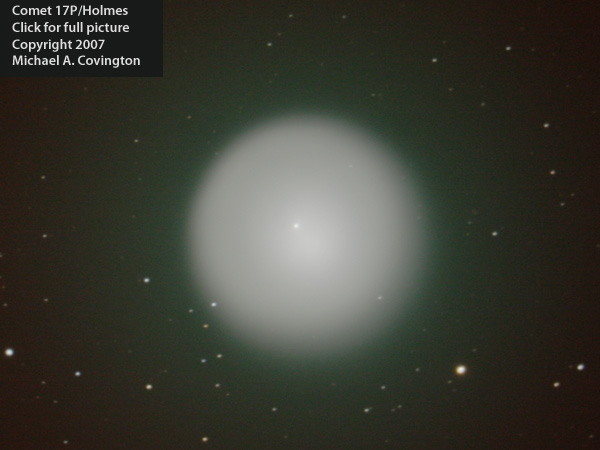
The evening of October 29 gave me the first opportunity to photograph the comet in a moonless
sky and check whether it has a tail. It does not, at least not that we can see.
(There could still be a tail pointing directly away from us.)
Above is a high-dynamic-range image made by mixing 6-second, 25-second, and 100-second
exposures.
And every time I adopt a new scale for these pictures, the comet outgrows them
and I am again having to say, "Click for full picture."
Below is a 2-minute exposure with a 105-mm lens at f/4, a more determined effort to
check for a tail or other outer structures. All I can see is a greenish symmetrical
cloud. The star Alpha Persei and the surrounding star cluster are at the right.
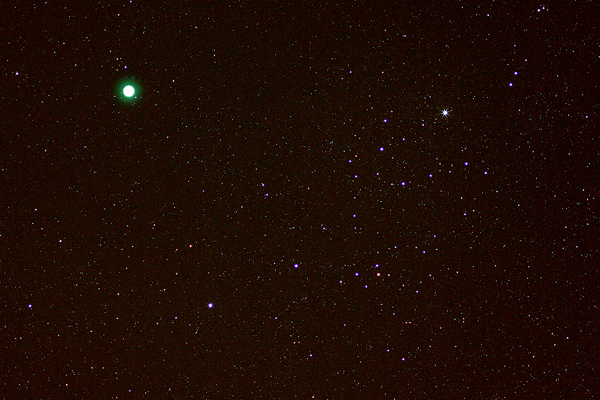
As a long time exposure, this is a bit misleading; it shows you how the stars and comet look
in binoculars except that the comet is just a fuzzball, not as bright as the brightest
star there. In the picture, the comet is very overexposed.
As of now, the comet is not losing brightness as I reported last night; this time
(Oct. 29, 9:30 p.m. EDT) it had apparently brightened up to magnitude 2.1 or so.
Permanent link to this entry


|

|
2007
October
29
(Extra)
|
High-dynamic-range image of comet
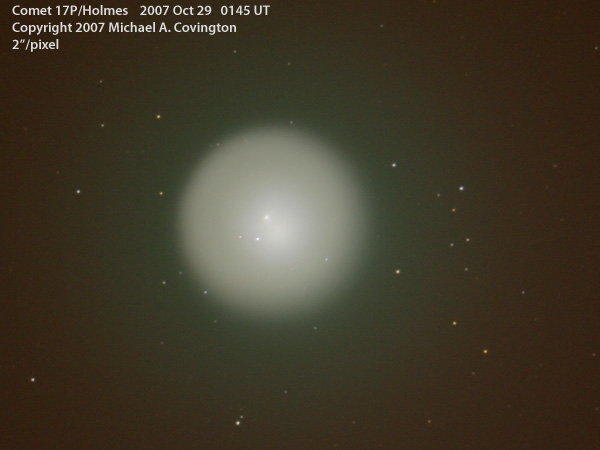
This is a high-dynamic-range image of the comet, made by mixing some 6-second and 25-second
exposures with a single 3-minute exposure. You can see some of the greenish gas cloud surrounding the
inner dust cloud.
The picture is cropped tightly enough that vignetting is not a factor; that is the darkening
toward the edges is not due to the lens system.
Permanent link to this entry


|

|
2007
October
29
|
Bigger but dimmer
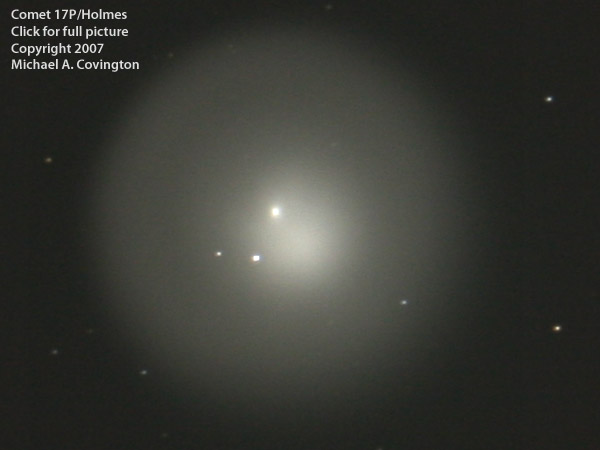
This is the last picture I'm going to be able to present at a scale of 0.93"/pixel because,
as you can see, the comet is outgrowing the web page.
(I still limit all pictures to 600 pixels wide so that the Daily Notebook is
readable on a 600×800-pixel screen.) You can click for the full picture, but very
soon I'm going to switch to a lower magnification.
But it's losing a bit of brightness.
Yesterday evening (Oct. 28), it was still clearly visible to the naked eye,
and perceptibly fuzzy, but (as best I could tell) slightly fainter than Algol,
down to magnitude 2.5 or so, having peaked at 2.2.
In the picture, a couple of stars are visible through the comet, just below its
nucleus. The brighter one looks elongated because it is a double star, ADS 2777.
This is a color picture. The comet is very neutral-colored to both my eye
and my camera.
Permanent link to this entry


|

|
2007
October
28
|
Another evening with the comet
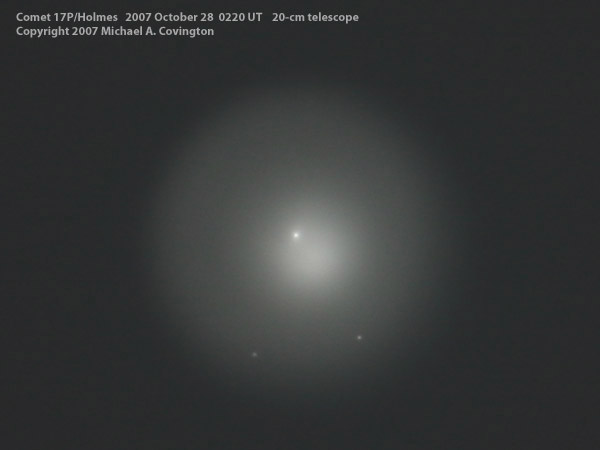
Size corrected Oct. 28.
Here's a third telescopic picture of Comet Holmes, to the same scale as the previous two.
This time the comet is passing in front of two stars. It's growing! Here's a comparison
of the past three days' images, reduced to a scale of 2" per pixel:
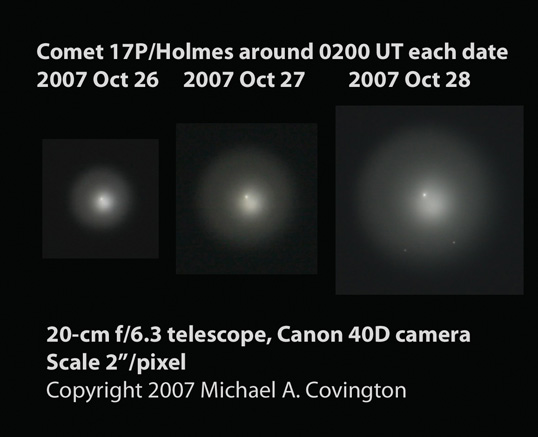
Experts tell me this outburst may not last long. Although the comet will be in the evening
sky for months, we don't know whether it will keep giving off gas and dust long enough to
form a tail (other than the paltry one it presumably already has, which is pointing directly
away from us). It may just fade into obscurity again.
Indeed, there is already ground for concern.
The dust cloud is expanding but the brightness of the comet is not increasing — it's
still magnitude 2.2. The dust cloud may just puff out and vanish, leaving the comet
as small as before.
Incidentally, this comet is not headed toward the earth.
Its orbit is well known. If it does have a tail pointed away from us, that doesn't mean
it's headed toward us. Comet tails don't trail after them; they always point away from the sun,
and at the moment, the comet, the earth, and the sun are nearly in a straight line.
Permanent link to this entry
Overweening?
Why are the mass media going so overboard with Halloween this year?
You can still take refuge in the Daily Notebook, which is possibly the only thing left in
American journalism that isn't Halloween-themed.
And the only thing in American journalism
that hasn't mentioned Paris Hilton or Britney Spears. (Until now. Oops!)
For the curious, overweening is a rather rare word that means
"arrogantly excessive." It does not normally have anything to do with Halloween.
Nor "Hollow Ween," the mispronounced (or maybe vacuous) holiday that we hear so much about!
Permanent link to this entry


|

|
2007
October
27
(Extra)
|
A fast-growing comet
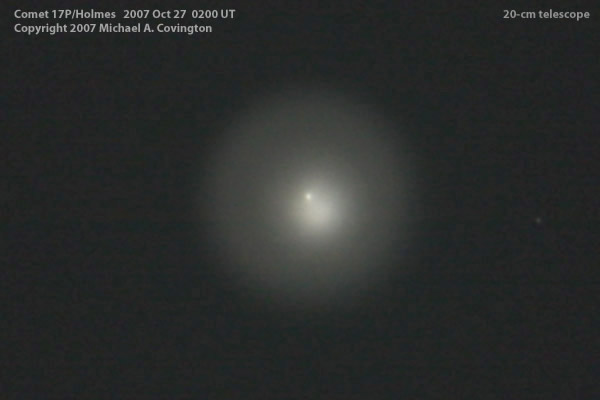
Look at how Comet Holmes has grown in 24 hours. This picture
was taken with the same equipment and exposure
as yesterday's
and is reproduced at the same scale (0.93 arc-second per pixel).
You can tell that the dust cloud is expanding.
I expect this comet to have a fine tail in a few weeks.
Permanent link to this entry


|

|
2007
October
27
|
Vista 64: "The server does not have the correct printer driver installed"
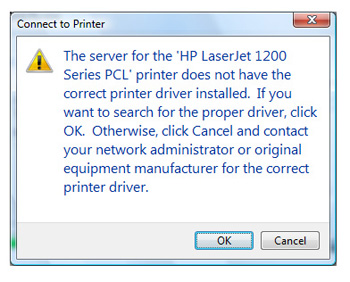 Problem: You are using a Vista 64 machine to access a networked printer.
Drivers should install automatically, but the server is a 32-bit machine and
doesn't have Vista 64 drivers. Vista doesn't know what to do.
Problem: You are using a Vista 64 machine to access a networked printer.
Drivers should install automatically, but the server is a 32-bit machine and
doesn't have Vista 64 drivers. Vista doesn't know what to do.
Solution:
Install the printer locally (as "Print To File" or something) and then change its port to \\servername\printername
by doing an Add Local Port and typing exactly the port name that is used on other PCs connecting to the
same shared printer.
I learned this as part of spending a day with Cathy's dual-core 64-bit PC, which she kindly lent me
so I could test software.
Permanent link to this entry
How not to ration water
We are having a severe water shortage in Athens, Georgia, caused partly by a killer drought
and partly by the real-estate bubble (resulting in too much building and too much demand for
water in a small area).
Our left-wing city government is proposing to require every household to limit its water use
to a certain percentage of what it used last year or the year before.
Bad idea. That would reward the people who have been wasteful in the past, and punish
those who conserved water all along. Not to mention having absurd results when the number of
people in a household has changed.
My counterproposal — which is not original with me — is to raise the price of
water and charge whatever it really costs, but, to prevent hardship, allow each person
(not household or building) a quota of water at the old, low price.
Then everybody would have an incentive to save water.
True socialists would object that my plan favors the rich.
But isn't it even worse to favor the wasteful? And anyhow, the proposed plan also
favors the rich, who were the big consumers in previous years.
Permanent link to this entry


|

|
2007
October
26
|
Comet with gas/dust cloud
Updated
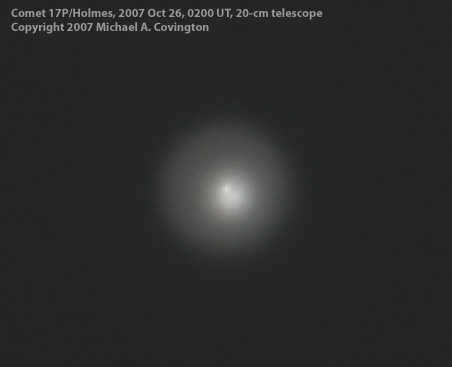
This is a high-magnification view of Comet Holmes.
As you can see, it has a central, rocky or icy core (here gleaming white because
it is emitting gas and dust) and an expanding dust cloud around it, not entirely symmetrical.
The solar wind drives most of the gas and dust directly away from the sun, creating a tail, but
we don't really know if a tail has formed behind this one yet.
This is a stack of four 1.6-second exposures (Canon EOS 40D, ISO 400)
through an 8-inch f/6.3 telescope. It is a color picture and closely mimics
the appearance of the comet in the telescope.
I also took some wider-field pictures with a 300-mm lens even though the full moon
was only 40 degrees away. We don't know whether the comet is developing a larger cloud
of fainter material because the moonlight interferes with our view.
(That will change in a few days.)
But this picture does justice to the yellowish color of the comet itself and the
faint green of the gas surrounding it.
It is a much longer exposure (10 seconds at f/4), so the area shown in the first
picture appears as a solid bright disc.
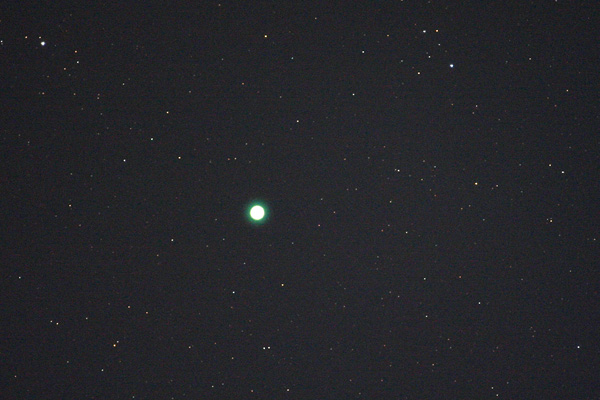
To the eye, the comet still looks like a second-magnitude star between Alpha Persei and Capella,
considerably closer to the former.
Permanent link to this entry


|

|
2007
October
25
(Extra)
|
Comet amid clouds
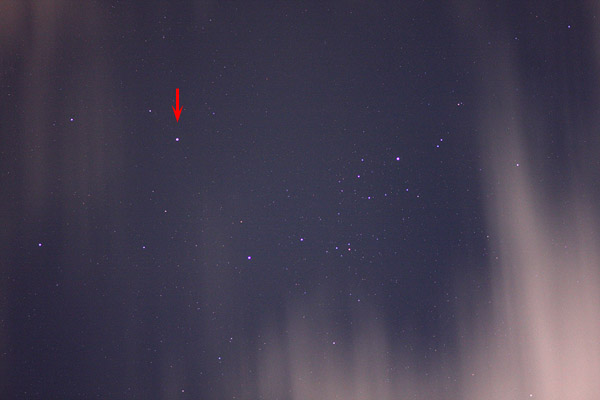
Just after midnight I managed to photograph the comet under very adverse
conditions. Those streaks are clouds drifting into the field
during the time exposure. This was approximately a 5-second exposure
(in full moonlight) at ISO 400 with a 105-mm f/2.8 lens on my Canon 40D,
piggybacked on an equatorially mounted telescope (although with a 5-second
exposure, a fixed tripod would do almost as well).
The bright star to the right of center is Alpha Persei; the bright star below center,
Delta Persei.
Viewed through a 5-inch telescope at 90×, this is obviously a
relatively distant comet viewed head-on, with its tail pointed
directly away from us. That is, it is a small but not quite starlike
very bright spot surrounded by a round bright patch with relatively well-defined
edges but considerable fall-off in brightness near the edges.
I did not measure its diameter, but a very rough estimate is 1 arcminute.
Tomorrow we'll doubtless see lots of good pictures of the comet from places
with better weather.
They're in the comet photo gallery on
www.spaceweather.com.
The picture above is more of a personal souvenir, to
record the fact that I saw it on its first night.
For years to come, amateur astronomers will ask each other,
"Where were you the night 17P/Holmes blew up?"
This is definitely the
oddest astronomical phenomenon I've ever seen, in the sense that
a rather thorough knowledge of observational astronomy would not have told
me what kind of object it was if I hadn't already known.
My first reaction would have been to call it a very bright nova —
but it's surrounded by a fuzzball, and over a timespan of hours or days,
it's moving.
Permanent link to this entry


|

|
2007
October
25
|
Updated...
Comet mimics 3rd-magnitude star?!
A comet that was predicted to be 17th magnitude (visible only with large telescopes)
has apparently brightened to 10th and then to 3rd magnitude, making it visible to
the naked eye — and it looks like a star, not a comet.
It's in Perseus, about 1/4 of the way from Alpha Persei to Capella and moving
north about 1/6 of a degree per day.
From the British Astronomical Association's electronic bulletin 00313:
In the past 24 hours, a spectacular event has taken place involving the
periodic comet P/Holmes (17P). Its predicted brightness is about magnitude
17; however last night it was discovered by the Spanish amateur, Juan Antonio
Henríquez Santana, to have undergone a tremendous outburst having attained
magnitude 10 at that time (Oct 24 0h UT). It was a similar outburst in 1892
that led to its discovery.
...
It has brightened to magnitude 2.5 (easy naked-eye visibility).
More details are on www.spaceweather.com.
What has happened, of course, is that part of the comet must have suddenly
broken open and vaporized, producing a bright cloud (though not, at this
point, a tail). A comet is a rather
loose aggregation of material, mostly frozen, and as it orbits the sun it
constantly changes temperature. This one apparently contain lumps of material
that can vaporize suddenly when the temperature
and position are right.
It's rare to see a 3rd-magnitude interloper in the sky, whether comet, nova,
or something else. If the clouds clear, I'm going to photograph this one.
If not, well, we're enjoying the much-needed rain!
Update: I saw it at 8:45 p.m. October 24, using 8x40 binoculars,
viewing through a rift in the clouds.
It looked almost like Jupiter, just slightly larger than a star, and yellowish
in color; total magnitude 2.2 to 2.5.
There was a hint of a tiny tail pointing downward (away from the sun) but
I wasn't sure. This has by far the highest surface brightness of any
comet I've ever seen.
Permanent link to this entry


|

|
2007
October
24
|
Just when you thought film was dead...
 Just when you thought film photography was almost dead,
Kodak has
re-engineered T-Max 400 film
and now claims a resolving power of 200 lines per mm (for high-contrast targets) instead of 125.
There are no announced changes in its reciprocity or spectral sensitivity
characteristics.
Just when you thought film photography was almost dead,
Kodak has
re-engineered T-Max 400 film
and now claims a resolving power of 200 lines per mm (for high-contrast targets) instead of 125.
There are no announced changes in its reciprocity or spectral sensitivity
characteristics.
What I think this means is that they've moved production to a different factory,
presumably a smaller one, and made an improvement in the product at the same time.
I hope to test the new T-Max 400, wondering if it will be
the last major black-and-white film product that I ever test.
But then, I've been meaning to test a lot of things related to film photography,
and somehow I never get around to it. Digital is so much easier!
Permanent link to this entry
PIC12F509 (and PIC12F508) gotcha
This evening (Oct. 23) I designed and built, from scratch, a 5-LED
persistence-of-vision display
using a PIC12F509 and a lithium coin cell as the power source.
We are thinking of using this as a "learn-to-solder kit" for students in the robotics course.
We'll have a printed-circuit board mass-produced and make kits of parts.
The more highly motivated students can customize their microcontrollers.
It's potentially a lot more fun than just building a circuit that makes one LED blink.
Along the way I found a "gotcha." Even after setting pin GP3 to output, it didn't
function as an output. It turned out that GP3 is also the timer input. You must
also use an OPTION statement to tell the timer not to use an input pin.
Permanent link to this entry


|

|
2007
October
23
|
Catching up
If you're having trouble keeping up with the Daily Notebook,
today's your day to catch up.
I'm too busy to write anything new.
Permanent link to this entry


|

|
2007
October
22
|
"Imposing your values" on other people
Have you ever noticed that people who object to your "imposing your values" on them...
...or people who object to "value judgments"...
...only become allergic to these things when you say something with which
they disagree?
The rest of the time they "impose" their own "value judgments" on other people constantly.
It came as a relief to some of the audience of my talk the other day
that "You have no right to impose your beliefs on me" is not a widely recognized, deep
philosophical insight — it's a silly 1970s catch-phrase, and I'm not entirely
sure what it's supposed to be arguing against.
The physical world is constantly "imposing" beliefs on us all the time.
Is it raining or not? How do you know? Do you get to make up your own answer,
or do you have to look out the window?
I'm in favor of freedom of thought because I believe in
objective truth, not because I think there's no truth to be had.
If truth is objective, then we might all be wrong, so we should let other people
think for themselves and criticize our ideas.
Permanent link to this entry


|

|
2007
October
21
|
Short notes
I'm testing a
FotoSharp T-ring for Canon EOS.
It goes in place of your regular T-ring and contains electronic circuitry
to make the camera think it's connected to an EOS autofocus lens in manual-focus mode.
You can then get electronic focus confirmation when focusing your telescope.
Preliminary verdict? It works. It's not a panacea, but it's a useful tool.
Here
is a sketchy report of what might be a
really bad idea from the Romney campaign:
Linking college financial aid to the student's choice of career goals.
Why is it a bad idea? Because it's a sure-fire way to get a
big surplus of whatever was in short supply 5 or 10 years earlier.
Even without government intervention, we already have this problem:
Word gets out that a particular part of the job market is "hot," and for several years,
all the dull undergraduates want to go into it.
First it was MBAs, then computer science, then MBAs again...
My advice to students is always, "Don't major in something that already has too
many people majoring in it."
Cathy adds two more very important observations about this.
(1) College isn't job training. English majors can perfectly well become bankers;
pre-med majors end up programming computers; and so forth. If financial aid is tied to the
notion that college prepares you for one specific job, you've reduced college to
trade school.
(2) Under the American system,
a student doesn't even have a definite major much of the time.
Many students are officially undecided for a year or more; would they not be able
to get financial aid?
It would be quite easy to list your major as one thing to get financial aid, but take
courses that will equally well
qualify you for something else, and change directions at the very
last moment. In fact, it is common for students to decide their exact specialty toward
the end, when they look back and see what they've gotten!
I think this is a good practice, but under the proposed scheme, it would presumably be forbidden,
or if done, would become a dishonest practice.
And here
is a good essay on political desperation, or why you shouldn't lower your standards when
choosing a candidate to vote for.
Permanent link to this entry


|

|
2007
October
20
|
I've been censored! (?)
I've been told that this Notebook is not accessible from the network of a nearby
college — that people get "Access denied."
I'm trying to contact their network administrators. Does anybody know anything about this?
Presumably, they use some kind of porn-blocking system that has outsmarted itself.
[Oct. 25:]
I'm told I wasn't being censored after all, and we
don't know what the problem was.
I think they do use porn filters, and it's possible somebody
had me incorrectly listed for a while.
Permanent link to this entry
This is a notebook, not a logbook
An interesting point came up while I was talking about blogging with some very smart
people at Cox Radio Interactive this afternoon (Oct. 19):
The Daily Notebook is not a "web log" of everything I do. Much of my work and
my personal life never get mentioned here. I don't want to bore you, and also, I don't think
the most important thing in the world is me.
This Notebook is written for you, whoever you are. That is, it's written for
other people to read. Mostly, people who use search engines and are led here in quest of
unusual facts that I've noted.
Permanent link to this entry


|

|
2007
October
19
|
How to write more clearly,
think more clearly,
and learn complex material more easily
Instead of writing much tonight, I'm getting ready to go give
this talk
to the employees of a business in a major city.
If you'd like me to give it to your group, let me know.
Permanent link to this entry
Miscellany
One of my current programming projects is a "screen scraper" that pretends
it's a human being and collects some information from web pages.
The WebBrowser
component
in .NET 2.0 and 3.0 is very handy for this, since it analyzes the web page into
a tree structrure of objects (text blocks, links, frames, etc.).
Another famous blog
decides
not to have comment buttons,
just like me.
Don't worry, there are plenty more astronomical pictures coming soon!
Permanent link to this entry


|

|
2007
October
18
|
Morphing faces
I'm too busy to write anything today, so watch
this video instead.
Permanent link to this entry


|

|
2007
October
17
|
A Nikon without a "star eater"
Nikon D300 apparently does not require Mode 3
 According to
tests by
Christian Buil,
the
new Nikon D300
apparently
does not suffer from the
"star eater" phenomenon
(that is, does not require the improvised "Mode 3" for astrophotography).
According to
tests by
Christian Buil,
the
new Nikon D300
apparently
does not suffer from the
"star eater" phenomenon
(that is, does not require the improvised "Mode 3" for astrophotography).
And it has live focusing and a big 3-inch LCD.
So although it's expensive ($1900), this may be the first Nikon DSLR that's really
good for astrophotography.
I'll post more information when it comes my way.
Permanent link to this entry
Miscellany for gadgeteers
I'm too busy to write anything. So look at
this fellow's
homemade
phonograph
for Edison cylinders...
and this
summary of
California's requirements for lights on automobiles
(relevant to me because I'm trying to rig our minivan so I can drive away
from astronomy events without disturbing others)...
and this account of
where
a corporate spy might hide a hard disk.
Permanent link to this entry


|

|
2007
October
16
|
Short notes
No pictures today; I'm too busy
making
the world a safer place.
But here are a few things I've learned lately...
The proper float-charge voltage for a 12-volt gel-cell battery is 13.5 V, not 14.0 V as I had thought.
(The higher voltage is apparently OK for wet cells.) I built a float-charge regulator from a slightly
higher-voltage power supply and a 7812 chip with a green LED in series with its ground lead.
Apparently, at the low current involved, the green LED drops only 1.5 volts, raising the output to 13.5
instead of 12.
Zeiss is still making
lenses with M42 screw mounts, partly (I think) to cater to Canon DSLR users with
lens mount adapters. But, apart from mechanical construction, is their 50/1.4 Planar
sharper than Canon's 50/1.8 Planar derivative?
I don't think so... except that Zeiss may control unit-to-unit variation more tightly.
At ten times the price.
Should you refinance your mortgage?
Not if it's at 5.125% (fixed), the way mine is.
But if you're wondering, a team of economists has come up with a
calculator
that includes not only the predictable factors, but also the probability of
variation in future mortgage rates, the rate of inflation, and so forth.
Details of their theory here.
Permanent link to this entry


|

|
2007
October
15
|
Peach State Star Gaze finale
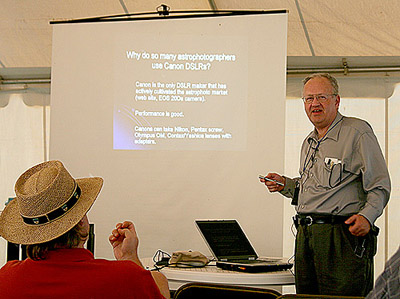
The Peach State Star Gaze had its last full day on Saturday the 13th, and I spoke on
digital SLR astrophotography.
It was gratifying to meet a lot of people — including one editor of
Sky and Telescope — who said that they got their start in astrophotography
using my book, Astrophotography for the Amateur, in the 1980s.
Around the turn of this century, photography
almost completely displaced visual
astronomy even among amateurs, and I helped make it happen.
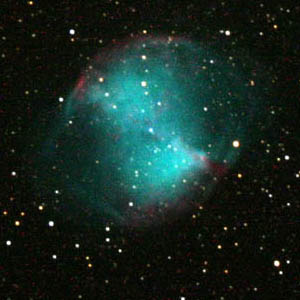
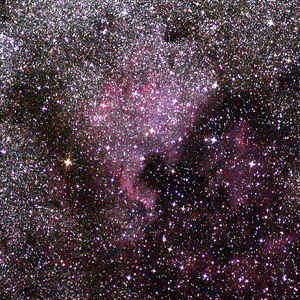
Here are two pictures, presented here in rough form; better versions are coming soon.
Each is a single 6-minute exposure with a Canon 40D at ISO 800.
First, the Dumbbell Nebula (M27) through my 8-inch telescope at f/6.3;
second, the North America Nebula through a Sigma 105-mm lens at f/4.
Permanent link to this entry
Gadget of the day: Lafuma RSX folding chair
 Our latest piece of astronomy gear is an
incredibly comfortable
Lafuma RSX folding recliner.
Melody took it to the PSSG, got in, leaned all the way back, and promptly went to sleep.
It's much more comfortable than an air mattress, and I'd use it for a bed if I went camping.
It folds up compactly but unfolds to something that resembles a 1970s Air France airplane seat,
more comfortable than a La-Z-Boy recliner. There are different varieties for people of different
heights; we have the RSX, for people slightly less than 6 feet tall. You don't have to shoehorn
yourself into a chair designed for a small person.
Our latest piece of astronomy gear is an
incredibly comfortable
Lafuma RSX folding recliner.
Melody took it to the PSSG, got in, leaned all the way back, and promptly went to sleep.
It's much more comfortable than an air mattress, and I'd use it for a bed if I went camping.
It folds up compactly but unfolds to something that resembles a 1970s Air France airplane seat,
more comfortable than a La-Z-Boy recliner. There are different varieties for people of different
heights; we have the RSX, for people slightly less than 6 feet tall. You don't have to shoehorn
yourself into a chair designed for a small person.
Permanent link to this entry


|

|
2007
October
13-14
|
Invitation to an art show
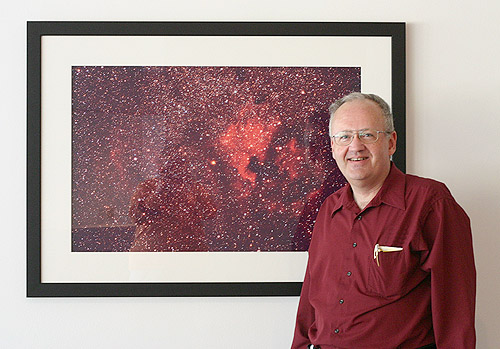
If you find yourself on the south side of Athens, Georgia, between now and December 22,
let me invite you to an exhibit of my astronomical photographs
in the Bertelsmann Gallery of Athens
Academy. That is the lobby of the building that contains the Presentation Hall and
school library. There is no formal opening ceremony, but the building is open during business
hours every weekday and before and after concerts and plays. Come one, come all!
And yes, the pictures are for sale.
Permanent link to this entry
M33 done right
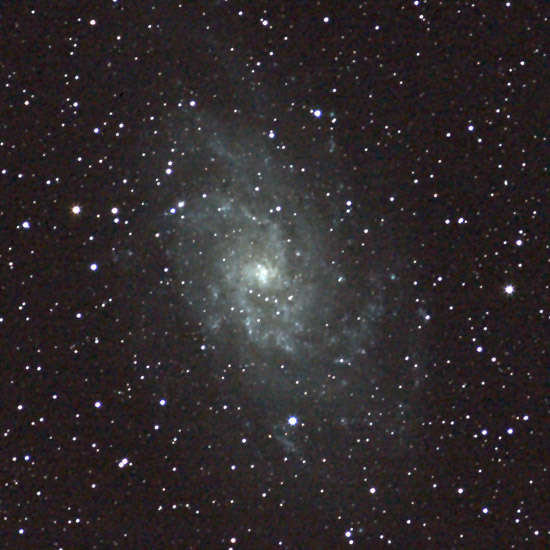
This is my picture of M33 (the Triangulum Galaxy) from Deerlick in finished form
(except that it has been scaled down for the Web).
This is a stack of three 6-minute exposures with a Canon 40D at ISO 800
through a 300-mm lens at f/4.
Permanent link to this entry
The North America Nebula
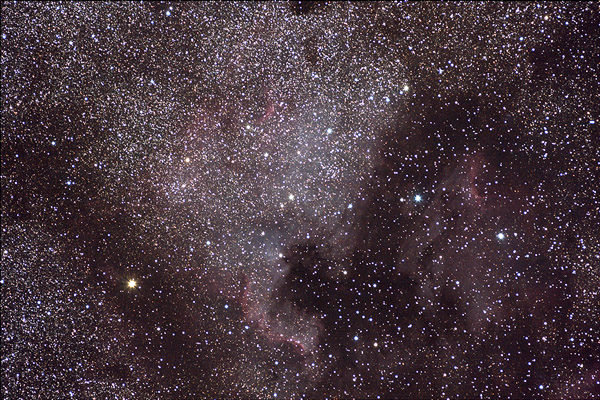
Click to enlarge
Another Deerlick picture, same equipment and technique as the preceding one —
again, a stack of three 6-minute exposures.
Note the subtle colors. This camera has not been modified to change its spectral sensitivity.
Permanent link to this entry
The Veil, east and west
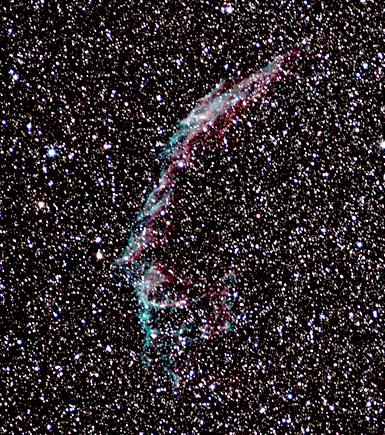
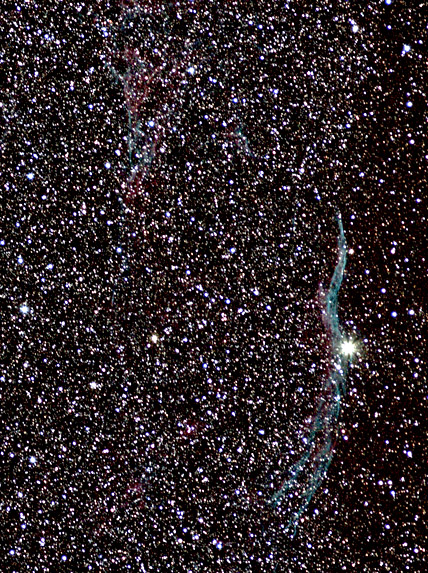
Here are the eastern and western segments of the Veil Nebula, fragments of a supernova
that exploded long ago. These are actually two sections
of the same picture, of which I'm going to make a large print. This is a stack of six
6-minute exposures, the most exposure that I've lavished on a single picture in quite a while.
Permanent link to this entry


|

|
2007
October
12
(Extra)
|
M31, going even deeper
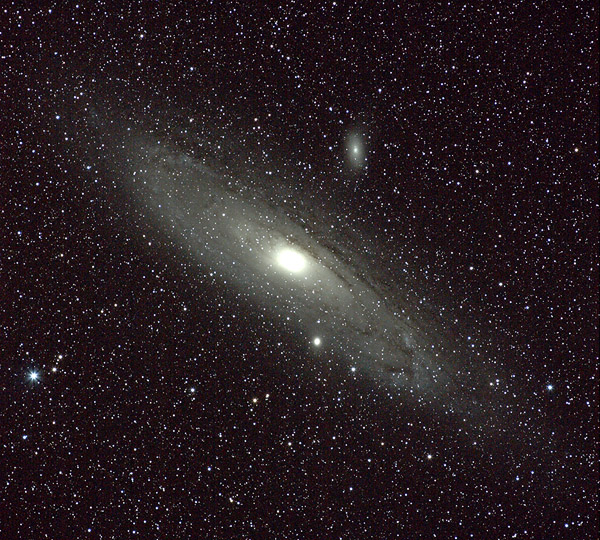
Click to enlarge
This is the same image as the one shown below, but
processed differently to show more of the outer reaches of the galaxy.
Permanent link to this entry


|

|
2007
October
12
|
M31 from Deerlick
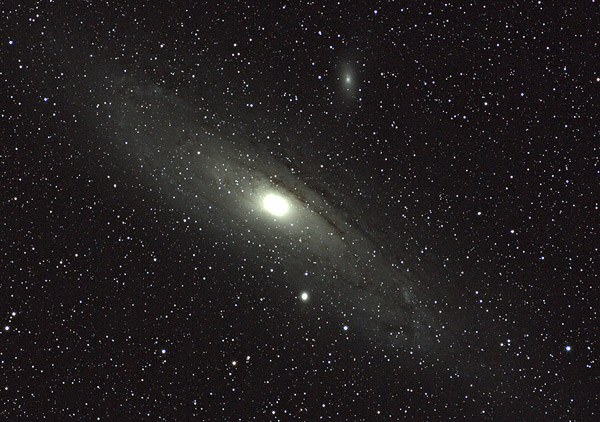
Click to enlarge
This is a quick snapshot of M31, the Andromeda Galaxy, from Deerlick
— that is, I only took two
exposures, each 6 minutes at ISO 800, with a 300-mm lens at f/4. Dark-frame and flat-field
correction was applied. Think how much it might have shown if I had exposed longer!
This rather beats the one I did from home, doesn't it?
Permanent link to this entry


|

|
2007
October
11
|
M33 from Deerlick
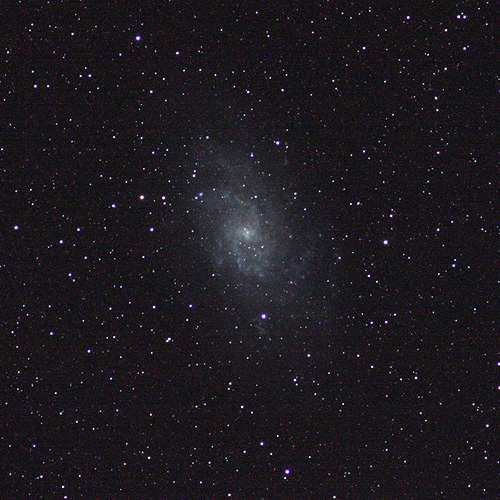
Yesterday evening (Oct. 10) I went to Deerlick,
where the PSSG is still going on,
and this time I took my telescope. Here you see a very quick preliminary version
of a picture of the galaxy M33. This is a single 6-minute exposure with a Canon EOS 40D
set to ISO 800 and a 300-mm f/4 lens, piggybacked on the telescope to track the stars as
the earth rotates. A much better version of this picture, combining several exposures,
is coming.
Permanent link to this entry


|

|
2007
October
10
|
PSSG and Grier country
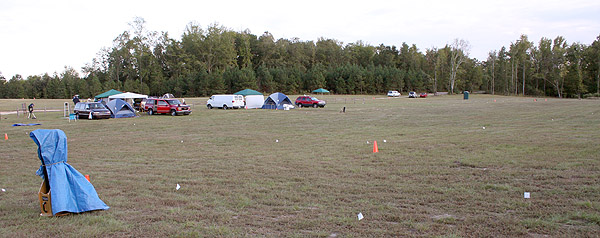
This is what the Peach State Star Gaze looked like on Sunday when only a few people
had arrived. Amateur astronomers, almost all of them camping, will cover much of the
field by this weekend. Setups range from RVs with power generators to small cars and pup tents.
This field is historically important;
it belonged to Robert Grier, Georgia's first prominent amateur astronomer,
who founded Grier's
Almanac in 1807. It is still published.
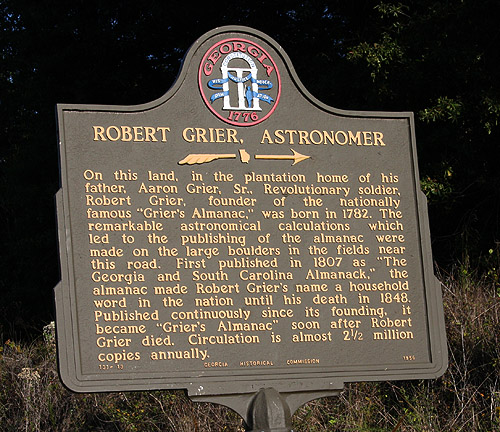
I'm not quite sure what they mean by saying he did the calculations on the boulders.
Maybe he used them as slates, or maybe he used them to sight the sun.
It was my grandmother's copy of
Grier's Almanac that helped get me interested in astronomy around 1968.
Farmers rely on the almanac for planting dates, times of sunrise and sunset, and typical weather data
for different times of the year. But it is a strange publication, harking back to an era when
astronomy and astrology were not distinct.
Permanent link to this entry
Lizard ride-along
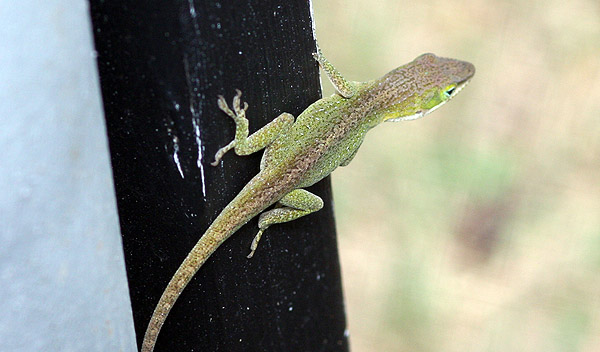
This female Anolis carolinensis has been a frequent sight around my telescope pier
this month, and on Monday she decided to go to work with me.
I had gotten about a mile and a half down the road when I realized I had a hood ornament —
or rather a live lizard trying to play that role. I slowed down and thought about putting her onto
the ground or shrubbery
where I was, but then decided she was far too valuable to me as a mosquito-eater and mother of future
mosquito-eaters. So I carefully drove back home, calculating my speed so she would crouch down
and not try to move, and returned her to her native habitat.
Permanent link to this entry
Scaling down Christmas?
In the 1950s, American businesses successfully changed Christmas from a religious holiday
into a children's toy-and-shopping festival.
Now there are signs the trend is reversing.
In particular, experts are telling merchants to expect
a scaled-down holiday spending season
this year.
In other words, we're finally getting the less-commercialized Christmas that we've
been saying we wanted since about 1960.
This is probably the result of several factors. Here are trends that I see:
(1) Obviously, people are more frugal because of
the subprime lending crisis and other perceived problems with the credit industry.
This is a good thing.
(2) Increasing exclusion of religion from public life. Of course, Christians still
celebrate their holy day.
But the general public is less willing to celebrate a holiday with a religious name
and no real religious significance — which is what "Christmas" as a toy festival
had become.
So this one has backfired on its proponents. If you take Christ out of Christmas, eventually you
have no Christmas at all, not even the commercial side of it.
(3) Possibly a trend away from treating children as well as they were treated in the 1960s.
This is not a good thing.
Perhaps the best thing about growing up when I did is that, in the early 1960s,
American society placed a very high value on children and treated us as a national
treasure.
Permanent link to this entry
Miscellany
Some of this text was accidentally omitted in the first upload.
I went today to get a new lead-acid gel cell for my telescope power pack and was
delighted to discover that the new one weighed only half as much as the old one.
What have they invented, lightweight lead?
Mass production of computer UPSes has probably spurred demand for highly
weight-efficient lead-acid batteries. A large part of the cost of a UPS is
the cost of shipping it to you. UPSes use the same kind of gel cell as my power pack.
By the way, your UPS probably doesn't work if you haven't replaced the batteries within
the past 5 years. It will seem to be OK but will only power the computer for a very short time
if power fails.
In other news, the person who wanted me to send my camera to Nigeria is now asking me for a refund.
Fat chance, considering I never got any money from him.
Permanent link to this entry


|

|
2007
October
9
|
Uploaded early. I'm busy today!
Another scam — but they didn't get me
My Canon XTi sold very quickly through Amazon. For anyone who isn't familiar with it,
I'm an Amazon Seller and can list things in the "new and used" category on Amazon.
Normally this is how I dispose of books, but it worked very well for a camera too.
But along with the genuine sale to a gentleman in Montana
(which is actually shown in my Amazon account when I log on), I got a flurry
of correspondence from people trying to steal the camera one way or another.
Of course, any Amazon customer can write to me with questions. But I was wary
when I started getting vague questions like "can you ship this to me?"
since information about shipping is already on Amazon.
Prospective buyers are welcome to contact me, of course, but they should only
need to do so if they have questions about the item itself.
One fellow asked if I could ship it to Indonesia. Another generated a
fake Amazon "Sold, ship now" e-mail that told me I had been paid for it
($100 over my asking price!) and needed to ship it to Nigeria.
Of course, Amazon's real message to me, about the real sale, told me
to log on to my account to get the details, which I did.
What's the root of the problem here?
E-mail needs to be re-engineered so that all messages can be authenticated.
I know fakery will never be impossible, but it could easily be made a lot
harder than it is now.
I am also prodding Amazon to warn their sellers.
And, of course, I've sent abuse reports to the ISPs from which the fraudulent
material appears to have been sent.
Permanent link to this entry


|

|
2007
October
8
|
Serial-port shutter control for Canon EOS 40D
I spent Saturday evening inventing this:
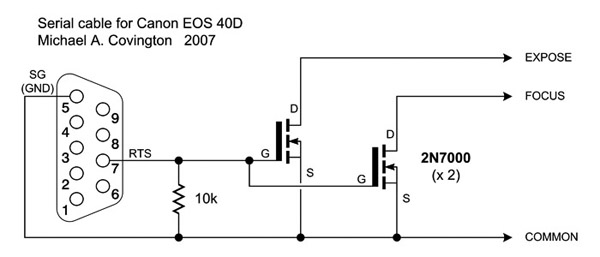
It's a cable that allows the serial port of a PC (or, in my case, a similar port
on a homemade microprocessor-based timer) to control the shutter of a Canon EOS 40D,
and it satisfies the 40D's requirement that two separate switch closures be simulated at
the same time. Read more about it here.
Permanent link to this entry
PSSG!
The
Peach
State Star Gaze
is now under way at
Deerlick
Astronomy Village.
Melody and I dropped in briefly Sunday evening.
It's a great place!
Just 63 miles from Athens, lots of room,
electric power, and bathrooms with running water available.
Basically, the field that we use is a campground for astronomers, although I won't camp there;
instead I get to figure out how to deftly depart around midnight without emitting much light.
(I park at the exit of the field and drive out using parking lights, so that only the red
tail lights shine on the observers.
As far as possible, I use the parking brake rather than the main brakes, so that the brake lights
don't come on.)
The sky is dark enough that cars and tents on the field are only visible with difficulty,
and the Milky Way is very detailed — it looks "painted on." M31 is prominent to the
naked eye and M33 is prominent in binoculars.
Pictures soon.
In other news, my Canon XTi has sold already, via Amazon. Thanks to all who inquired!
Permanent link to this entry


|

|
2007
October
7
|
M31 through mist
First light with the Canon EOS 40D
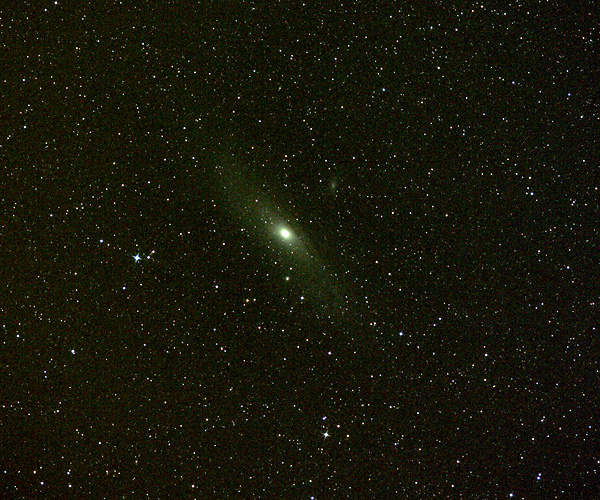
Here you see proof that the EOS 40D works. This is a single 3-minute exposure of M31,
the Andromeda Galaxy, through a gap in the clouds on the evening of October 5th.
Dark-frame subtraction was performed in the camera. Live focusing is a real boon; I have
not yet determined whether the 14-bit depth of the pixels contributes to image quality,
compared to the 12-bit-deep Digital Rebel XTi.
The very first astrophoto taken through this camera was a short exposure of
Sagitta very similar to the picture posted here on October 1.
I have made one important electrical discovery about the 40D: In order to hold
open the shutter on Bulb, both contacts have to be grounded (the one that actuates
autofocus and the one that opens the shutter). It's not sufficient to ground the
shutter contact alone. In due course I'll revise my notes on www.dslrbook.com.
Permanent link to this entry


|

|
2007
October
6
|
Uploaded early. Read tomorrow's news today!
Why the Daily Notebook doesn't have a comment button
Further to yesterday's remarks, Bruce Baker referred me to
this column
in which Joel Spolsky quotes Dave Winer to the effect that:
| |
To the extent that comments interfere with the natural expression of the unedited voice
of an individual, comments may act to make something not a blog.... The cool thing
about blogs is that while they may be quiet, and it may be hard to find what you're
looking for, at least you can say what you think without being shouted down.
This makes it possible for unpopular ideas to be expressed.
|
|
Precisely. Some ideas cannot be expressed if constant heckling is present,
or if one is obliged to refute every counterargument.
That's why my Daily Notebook has no comment button.
Several times, I've had to say to people who wrote in,
"Why don't you start your own blog to express your own ideas?
This one is mine."
Permanent link to this entry
Electronics in full bloom
After a few dull decades, a very welcome flowering of
amateur electronics creativity is now taking place.
Look for example at Lady Ada's kits,
the Make Blog,
and (just to choose one example at random)
Mondo Technology's Super Probe.
It's almost 1955 all over again!
Permanent link to this entry


|

|
2007
October
5
|
The next wasteland of the Internet
"Not everyone has something to say. This will not stop them from saying it."
—
Leonard Pitts.
The latest trend is for newspaper web sites to allow readers to reply, commenting on the
news stories. This can be useful, but the problem is, many newspapers have chosen to make
the comment forums anonymous and unmoderated, thus providing another soapbox for
complete idiots (or worse) to spout complete idiocy (or worse).
Click on the Leonard Pitts link above for more about just how badly this is going.
People are actually posting pornography and messages of racial hate as "comments" on
news stories that they have nothing to do with.
Permanent link to this entry
Happy birthday, Melody!
And happy 50th birthday (yesterday) to Sputnik.
I assure you Melody and Sputnik are not related.
Melody is appreciably younger and prettier!


|

|
2007
October
4
|
The EOS 40D user interface

The EOS 40D takes excellent pictures, although it will be a while before the
weather allows me to try it for astrophotography.
Meanwhile, I appreciate the thought that went into its user interface.
In particular, the idea of menu shortcuts has appeared in two forms.
First, in addition to the 8 regular menus, there's a 9th one called My Menu
on which you place your choice of items from the other menus.
Then all the settings you actually use are right at hand.
Here's my selection:
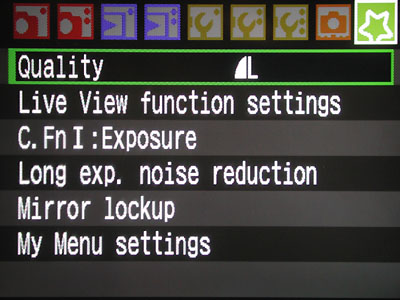
You can see that there's room for more.
Second, on the main function dial, besides all the modes denoted by little pictures
(which serious photographers never use) and the ones denoted by letters such as M, Av, Tv, P
(for "real" photographers), there are three that you define for yourself.
C1, C2, and C3 are sets of stored settings.
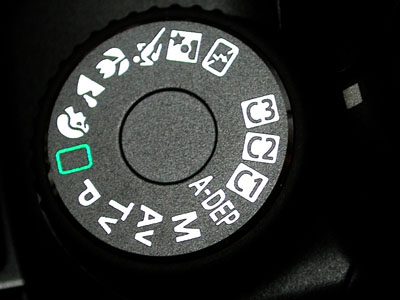
I've put my astrophotography settings in C3 so that I don't have to reset them one by
one when switching from daytime to astronomical work.
Permanent link to this entry
A soldering iron just for women?
The "pink typewriter syndrome" strikes again...
This evening, at a local craft store, I saw
a soldering
iron (purportedly) designed just for women.
I can't tell what marks it as feminine. It's not even pink.
It has a grippable surface which, as far as I can tell, is just as helpful
for male hands as for female ones.
(Some implements, such as bicycles, have male and female versions because women
are, on the average, a little smaller and wear different clothes.
I can't see how that applies to soldering irons.)
There is also a "creative screwdriver"
(why is it more creative than any other power screwdriver?),
a "creative rotary tool," and a few other items.
On the one hand, if all of this helps women overcome some prejudice against using power tools,
I'm in favor of it.
But on the other hand, who is telling women they can't use "men's" tools?
Permanent link to this entry
Shortwave radio and freedom
The following is a fuller version of a letter to the editor that appeared,
in shortened form,
in the October 2 Atlanta Journal-Constitution.
|
Shortwave radio crucial against censorship
In the midst of a violent political crisis, Myanmar has been cut off from the Internet.
Shortwave radio is now the only uncensored form of communication linking Myanmar with
the outside world.
This shows why shortwave radio, including amateur ("ham") radio,
is essential for safeguarding freedom.
Shortwave signals bounce off the atmosphere and travel worldwide without relying on
satellites or networks.
The only equipment needed is the radios on both ends, which can even be homemade.
We should be wary of efforts to make shortwave radio unusable in the United States,
whether by banning antennas in residential neighborhoods or by permitting too many sources
of interference on shortwave wavelengths. It's all very well to say that the Internet and
your cell phone will see you through, until one day they don't.
MICHAEL A. COVINGTON
Amateur Radio N4TMI
Athens
|
Permanent link to this entry


|

|
2007
October
3
|
Miscellany
The cloudy weather that has just hit Georgia is caused by my acquisition of an
important piece of astronomical equipment — a Canon EOS 40D that arrived today (Oct. 2).
Maybe it will give us some relief from the killer drought that has been going on since early spring.
Where to buy cameras online: I strongly recommend
Wolf/Ritz Express.
Extremely easy-to-use site, free shipping, and no sales tax!
If you're in Georgia, they discount the merchandise to absorb the amount of sales tax.
I paid a little more for overnight shipping and had the camera in 26 hours. It would have
been 23 if I'd been home at the right time.
I am sad to learn that
Charlie Moule (C. F. D. Moule), the British biblical scholar and
fellow of
Clare College, has died at age 98.
When I was a student 30 years ago he was already the grand old man to whom all the
evangelical students looked up.
Here
(in Scott Adams' blog) are some
very clear and intelligent remarks about global warming
from a Danish economist, followed by the observation that
almost nobody understood them.
The problem?
People — especially people watching TV, or reporting on TV —
don't think.
The economist's
most important point is that to reduce carbon consumption
worldwide, we have to reduce it
in developing countries, not rich countries, because they're so much more populous.
A few American yuppies with hybrid cars
won't make any difference. What we need are solar furnaces for Africa, or something
like that.
Why I don't like Facebook and have never used it:
It cheapens the concept of "friend"
into something silly.
People have to "invite" each other to "be my friend" and they compete to get the most "friends,"
many of whom they've never met or communicated with.
How disgustingly 5th-grade-girlish.
Don't worry, this Notebook hasn't changed entirely over to social commentary.
We'll have some computer technology tomorrow, or else some astronomy, I promise.
Permanent link to this entry


|

|
2007
October
2
|
Them's fightin' words, AT&T!
I have AT&T (formerly Bellsouth) ADSL service at home, and AT&T has
just announced changes to the terms of service which have
(quite rightly)
raised some controversy.
They say they reserve the right to disconnect my service
"for conduct that AT&T believes ... tends to damage the name
or reputation of AT&T, or its parents, affiliates and subsidiaries."
That, of course, is ridiculous. So I'm throwing down the gauntlet.
I am hereby criticizing AT&T for this foolish move.
My criticism, which you are reading right now,
presumably "tends to damage" their "name or reputation."
And if they disconnect my service,
I guarantee that they will get more publicity than they want.
(It also won't make this web page go away. It's hosted by
Sectorlink. AT&T only provides
my connection from home.)
The writer at Ars Technica astutely observes that AT&T's strange new rule is probably not
enforceable under U.S. law, and it probably isn't even what AT&T actually meant to say.
Maybe they were actually targeting some kind of fraud or hacking, not ordinary discussion.
But they didn't say so.
Or maybe they used boilerplate language for the employees' acceptable-use policy
instead of composing a new one for customers.
Whatever the reason, moves like AT&T's could be
a quick way to bring about heavy FCC regulation
of the DSL industry, especially if the Democrats win in 2008.
That's probably not what AT&T actually wants.
Permanent link to this entry
Must the news media embarrass the mentally ill?
A prominent citizen of a western state,
whom I will not name here in order to spare him further embarrassment,
recently called 911 to report intruders in his home;
he apparently turned out to be hallucinating.
Why do I know this? Because his hometown news media picked up the story and
spread it nationwide.
I don't think they should have done so.
The paper says this gentleman was recovering from a serious head injury.
And although I don't know what else might be wrong, I know that transient hallucinations
can result from reactions to many different medicines (even antibiotics) and from
physical disorders such as uremia.
The news media should not embarrass people who are suffering transient,
potentially embarrassing medical
problems — even brain symptoms — that have not endangered anyone else.
Nor should the police report this information to the public.
Surely medical privacy laws trump local laws about open records. Or do they?
Permanent link to this entry


|

|
2007
October
1
|
Arrow
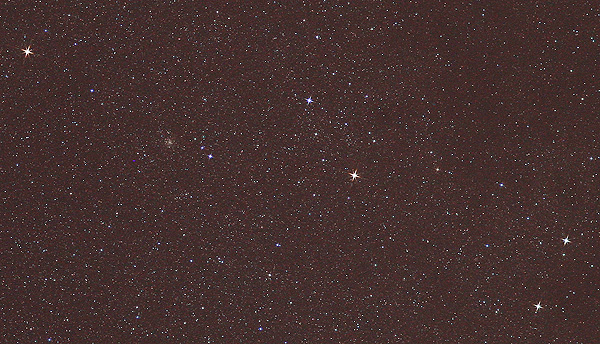
Click for larger image
On the evening of the 30th, we had about an hour between twilight and moonrise and the air was
unusually clear; I got the telescope out briefly.
This is the tiny constellation Sagitta (the Arrow), and, left of center, the enigmatic
star cluster M71.
What you see is a single, minimally processed 3-minute exposure with a Canon XTi and a Sigma
105-mm f/2.8 DG EX lens at f/4.5. A much better rendition of this picture is coming.
Permanent link to this entry
Life in the fast lane
This is a busy time of the year, especially since I was out sick for a week and have to deal with that
week's responsibilities. Here's a bit of what's going on:
- A new research collaboration with the UGa Terrorism Lab.
(Currently, if you look up my name on their web site, you get someone else's biographical information.
That's to throw off the spies... er, I mean, that's because they're not finished updating the web page.
Maybe it will be correct by the time you see this.)
- Fast-moving research projects that were already underway.
- Imminent release of
my new book.
- Saturday, October 13: I speak on digital SLR astrophotography
at the Peach State Star Gaze. Come one, come all!
- Friday, October 19: Trip to Atlanta to give a presentation, to an industry group,
on "How to Write, Think, and Learn".
- October 22 — December 14: My debut as an artist!
I'm displaying some astronomical photographs as part of an
exhibition at Athens Academy.
It's a joint exhibit with a distinguished art professor,
Michael Oliveri,
who uses a scanning electron microscope (the extreme opposite of my telescope).
Afterward, I'll take my pictures to some other local galleries.
Yes, the pictures are for sale, and they'll all be in nice frames.
- Possibly the imminent
arrival of a Canon EOS 40D, the DSLR I helped design.
Hang on to your hats! It's going to be a fast ride.
Permanent link to this entry


|

|
| |
Entries are most often uploaded around 0000 UT on the date given,
which is the previous evening in the United States.
| |
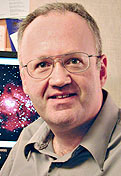















 Problem: You are using a Vista 64 machine to access a networked printer.
Drivers should install automatically, but the server is a 32-bit machine and
doesn't have Vista 64 drivers. Vista doesn't know what to do.
Problem: You are using a Vista 64 machine to access a networked printer.
Drivers should install automatically, but the server is a 32-bit machine and
doesn't have Vista 64 drivers. Vista doesn't know what to do.

























